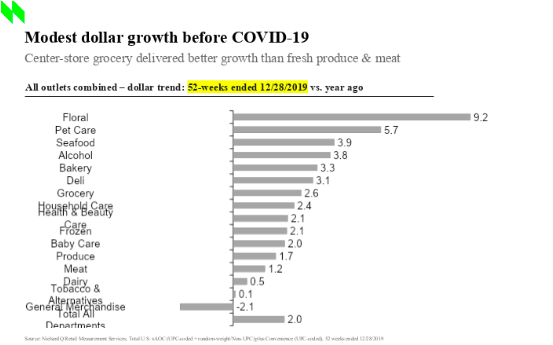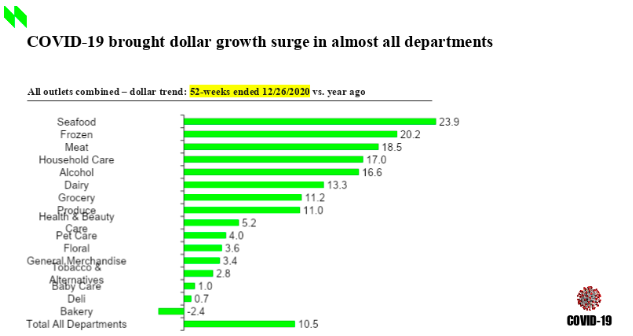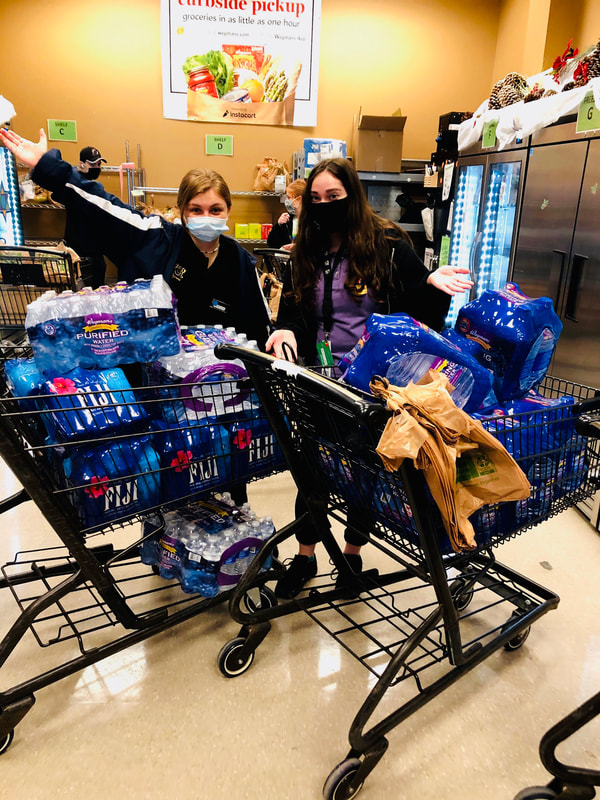For Instacart to continue to top the media charts as one of the best meal delivery services, it takes a village. Or, in this case, a team of college-aged personal shoppers to get the job done from grocery aisle to shopping cart to curbside delivery.
Morgan Piscatelli, who was a four-year Wegmans cashier before her current position as a part-time Instacart shopper since May, said the atmosphere of the Manalapan, NJ grocer has dramatically changed with the advent of COVID-19.
“It’s changed a lot — supermarkets have kind of become a place that is a little tense because people are afraid of the pandemic,” she said. “Since February, when the shelves first became empty, there are now limits on paper towels, cleaning supplies, and even coffee creamers (you can only buy two) because people aren’t going to coffee shops as much. And, people are buying more prepared foods because the typical sit-down, in-person dining experience is limited.”
Alas, here we have panic buying: the practice, as Piscatelli explained, made popular when thousands of Americans hoarded everything Clorox, Lysol, and Charmin Ultra Soft as numbers began to escalate. So much so, Costco reported a 12% increase in February 2020 sales as consumers clamored for cans of chicken soup and bags of white rice to stockpile in their basements.
Morgan Piscatelli, who was a four-year Wegmans cashier before her current position as a part-time Instacart shopper since May, said the atmosphere of the Manalapan, NJ grocer has dramatically changed with the advent of COVID-19.
“It’s changed a lot — supermarkets have kind of become a place that is a little tense because people are afraid of the pandemic,” she said. “Since February, when the shelves first became empty, there are now limits on paper towels, cleaning supplies, and even coffee creamers (you can only buy two) because people aren’t going to coffee shops as much. And, people are buying more prepared foods because the typical sit-down, in-person dining experience is limited.”
Alas, here we have panic buying: the practice, as Piscatelli explained, made popular when thousands of Americans hoarded everything Clorox, Lysol, and Charmin Ultra Soft as numbers began to escalate. So much so, Costco reported a 12% increase in February 2020 sales as consumers clamored for cans of chicken soup and bags of white rice to stockpile in their basements.
Data showing the impact of COVID-19 in terms of retail sales growth across measured departments, categories, and retail channels provided by NielsenIQ.
“Our goal throughout the pandemic has been to take care of our members and our employees, and serve the communities where we do business,” Muriel Cooper, Corporate Communications Specialist at Costco shared one year since supply shortages. “To do this, we’ve focused on keeping essential items in stock; maintaining a safe shopping environment by implementing a required mask policy and installing plexiglass at our registers; creating special hours for senior members and frontline workers; and streamlining our delivery systems.”
Demand and supply are certainly more balanced during the first quarter of 2021, but how did panic buying become an adopted norm during the viral outbreak?
For starters, the widespread impact of panic-buying arose because COVID-19 was not a short-term projection compared to hurricanes and snowstorms where consumers are prepared in advance — a distinction Todd R. Hale, Former Senior VP of Consumer and Shopper Insights at Nielsen shared via email.
What’s more, social media posts of empty shelves and long queues in supermarkets are linked to higher anxiety, organizational behavior researcher Andy J. Yap, Ph.D., concluded in his co-authored research.
“Social media becomes an echo chamber that heightens negative collective emotions,” he added in an interview. “People are afraid of losing out and thus go to the shops to panic buy. People who feel a loss of control tend to buy more utilitarian products designed to solve problems and to achieve certain goals, which helps restore people’s sense of control.”
And, this trend certainly crept into the doors of Wegmans. There are in-store Instacart shoppers (from aisle to car trunk) and full-service shoppers (from aisle to personal car to the client’s home). Piscatelli said curbside pickup orders have been higher than ever since the first COVID-19 cases. Having seven SUVs lined up in the shopping center and carrying 40 bags per Instacart order is so common, it’s become the new normal.
“On Saturday, when we don’t have enough staff, our phones will all be going off and we have to balance shopping for online requested items and bouncing to the street to load people’s trunks,” she said. “One time, we accidentally gave two customers the wrong bags because they had the same last name and they came at the same time. I also lost my shopper card in a head of lettuce, too. It gets very busy."
Demand and supply are certainly more balanced during the first quarter of 2021, but how did panic buying become an adopted norm during the viral outbreak?
For starters, the widespread impact of panic-buying arose because COVID-19 was not a short-term projection compared to hurricanes and snowstorms where consumers are prepared in advance — a distinction Todd R. Hale, Former Senior VP of Consumer and Shopper Insights at Nielsen shared via email.
What’s more, social media posts of empty shelves and long queues in supermarkets are linked to higher anxiety, organizational behavior researcher Andy J. Yap, Ph.D., concluded in his co-authored research.
“Social media becomes an echo chamber that heightens negative collective emotions,” he added in an interview. “People are afraid of losing out and thus go to the shops to panic buy. People who feel a loss of control tend to buy more utilitarian products designed to solve problems and to achieve certain goals, which helps restore people’s sense of control.”
And, this trend certainly crept into the doors of Wegmans. There are in-store Instacart shoppers (from aisle to car trunk) and full-service shoppers (from aisle to personal car to the client’s home). Piscatelli said curbside pickup orders have been higher than ever since the first COVID-19 cases. Having seven SUVs lined up in the shopping center and carrying 40 bags per Instacart order is so common, it’s become the new normal.
“On Saturday, when we don’t have enough staff, our phones will all be going off and we have to balance shopping for online requested items and bouncing to the street to load people’s trunks,” she said. “One time, we accidentally gave two customers the wrong bags because they had the same last name and they came at the same time. I also lost my shopper card in a head of lettuce, too. It gets very busy."
|
Juggling bags upon bags of organic strawberries and Captain Crunch is no easy feat, especially if you’re timed.
Instacart workers, according to The Philadelphia Inquirer, face “unforgiving metrics,” as Instacart will dish out penalties for its employees if they are five minutes late to the delivery site or take longer than four minutes to accept and order inquiry. Though Piscatelli’s Wegmans-issued Instacart system has tweaked guidelines, she notes that she’s measured in SPIs — seconds per item. Yes, Instacart shoppers that populate grocery stores are actually on the clock for how quickly they can find Pillsbury cookie dough, and then how quickly they can dart to the opposite end of the store for the gluten-free fettuccine pasta requested by 20-mile-away Cindy on the app. And, shopper satisfaction is always mixed. Piscatelli said one time, a shopper took out their anger on her when she took an extra second to remember where a soup can was. But, as she was helping an elderly woman locate a tub of vanilla frosting, they spent some time talking about her 80 years of existence and saluted her with a “God bless you, dear.” It can be difficult to manage quality in-store customer service when you’re thinking about packing dish soap, baking powder, and multi-grain bread in a bag. Piscatelli said you’re timed from beginning to end, including checkout speed, how long it takes to stage items to be sent to the client, and puts emphasis on the fact that you need to be working as quickly as possible. She often double-checks, too, making sure that if an item is out of stock, she always has a replacement in mind to suggest. |
“One time, I didn’t know if I checked out or not,” she said. “I had to call Instacart customer service twice to make sure it went through because I didn’t want to checkout twice and double-charge the customer. I worked an hour past my shift that night and, though I knew my SPI went down, I wanted to make sure the customer had the experience they wanted.”
Amid the shopping cart craze and tinkering with timing and aisle traffic, being a personal shopper is highly rewarding, especially at a time when it’s needed most. She speaks on behalf of all Instacart workers who streamline the shopping experience and make it more accessible, especially for the elderly and pregnant women, who are prone to be high-risk if entering a bustling Wegmans, Stop & Shop, or Whole Foods.
“When you’re shopping for people, you’re advocating for them and taking over the grocery process for them,” she concluded. “When I put groceries in the car, they are so thankful, yet at the same time, I’m thinking, ‘Thank you for giving me this job.”
Amid the shopping cart craze and tinkering with timing and aisle traffic, being a personal shopper is highly rewarding, especially at a time when it’s needed most. She speaks on behalf of all Instacart workers who streamline the shopping experience and make it more accessible, especially for the elderly and pregnant women, who are prone to be high-risk if entering a bustling Wegmans, Stop & Shop, or Whole Foods.
“When you’re shopping for people, you’re advocating for them and taking over the grocery process for them,” she concluded. “When I put groceries in the car, they are so thankful, yet at the same time, I’m thinking, ‘Thank you for giving me this job.”



